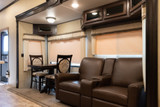Flock to Witness the Fall Migration of North America’s Sandhill Crane
When seasons change migration occurs. This doesn’t only apply to humans and their RVS. It also applies to the feathered kingdom.
Every year, people flock (pun intended) to see the gathering of the Sandhill Cranes during their semi-annual migration to and from warmer climates. For those who live in the northern tier of states, this migration season begins in late September and lasts until February. Common winter destinations for these birds is Florida, Texas, Utah, Mexico and California.
The birds put on a spectacle for the tourists, with elaborate mating dances and epic take offs and landings. Their distinctive call is hard to miss. Their characteristic flight style makes them easy to identify when seen aloft over harvested farm fields and Midwestern prairies and marshes.
In spring, the largest gathering of Sandhill cranes occurs along the Platte River basin in Nebraska. Hundreds of thousands of these ancient birds come together during the spring migration north. Known for their distinctive call and entertaining movements, the Sandhill Crane is like the Whooping Crane, but can be distinguished by its gray feathers and ornamental red head feathers, as well as its flight style.
The Sandhill crane is at home in prairies, fields, marshes, bogs and tundra, according to the Audubon Society. During their migration, the cranes leave their nesting sites and settle in prairies, farming fields and in river valleys. Wisconsin and Indiana are two primary migration stops on the cranes’ journey to the warmer climates.
The Sandhill Crane is an omnivore, meaning it feasts on plants, grains, mice, snakes, insects, or worms. The average life span of these birds is 20 years in the wild and their wing span averages 5 to 6 feet. Their body weight, however, reaches between 6 ½ pounds to 14 pounds.
Today’s Sandhill Crane bears an almost identical resemblance to a fossil found from the Miocene Epoch, which took place ten million years ago. These birds are found mostly on the North American continent, ranging from Mexico and Cuba to the south and Siberia to the west.
In Indiana, the Jasper-Pulaski Fish and Wildlife area in Medaryville is one of the staging areas for the fall- to winter migration. Here, the season peaks in mid-November with as many as 20,000 noisy birds congregating at one spot in Goose Pasture at sunrise and sunset. This is not their nesting grounds, but a place to mingle and socialize with others of their species. Their days are spent rooting for food in the marshlands and farm fields in the area.
Wisconsin is another staging area that attracts the Sandhill Crane. Several sites throughout the state provide viewing opportunities. Anyone interested is encouraged to take part in the annual crane count conducted by the International Crane Foundation in Baraboo, Wisconsin.
Other locations that draw flocks of Sandhill cranes in the fall include the Monte Vista/Alamosa National Wildlife Refuge in Colorado; Cheyenne Bottoms Wildlife Area, Kirwin National Wildlife Refuge; and Quivira National Wildlife Refuge in Kansas; Baker Sanctuary in Michigan; and Salt Plains National Wildlife Refuge in Oklahoma.
For those who enjoy nature, watching the migration of animal species can be a thrilling event on a bucket list. Animals migrate for many of the same reasons people move about – to escape extreme climates, to find a place to call home and raise children – and for reasons that ensure the survival of the species, such as travelling through breeding and nesting grounds.
Some would argue that human interest in the patterns of animals harks back to humankind’s ancient roots. Wildlife viewing is a pastime that many people enjoy when visiting state and national parks. Watching the massive migration of Sandhill cranes is one of those experiences that not everyone can witness. If you have the chance and are RVing in the northern reaches of this continent this fall, put it on your must-see list.
Recent Posts
-
Traveling to the RV Hall of Fame in Elkhart, IN
If you are traveling to Elkhart, IN to see the RV Hall of Fame, getting off the toll road at exit 96 …Nov 14, 2025 -
Best RV Air Conditioners of 2025: An Expert Guide From RecPro
Quick Answers Best overall RV air conditioner: RecPro 15K Quiet AC with Heat Pump (RP-AC3800) Best f …Oct 29, 2025 -
The Nuclear Nomads Expand Sofa with New Recliner Section Install
The Nuclear Nomads are a full time RV family living in south Florida. Andi and Joey value quality ti …Oct 24, 2025 -
Trailer Wiring Guide: How to Wire Your Trailer for Safety and Efficiency
Table of Contents 1. Common Types of Trailer Connectors 2. Trailer Wiring Diagrams: Color Codes and …Aug 20, 2024 -
How to Keep Your Pets Safe While Camping
RVing and camping are a great getaway from the hustle and bustle of work and the city and the day-to …Jul 02, 2024 -
Why Replace Your RV Furniture?
You may wonder when is the best time to replace your RV furniture. There is no one right answer to t …May 20, 2024







